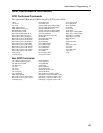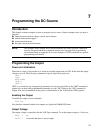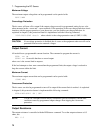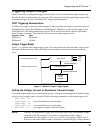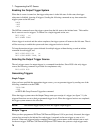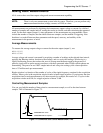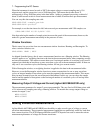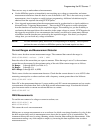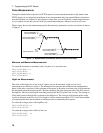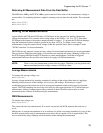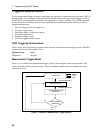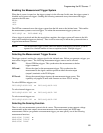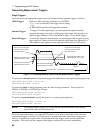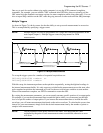
Programming the DC Source - 7
77
There are two ways to make enhanced measurements:
♦ Use the MEASure queries to immediately start acquiring new voltage or current data, and return
measurement calculations from this data as soon as the buffer is full. This is the easiest way to make
measurements, since it requires no explicit trigger programming. Additional calculations may be
obtained from the acquired data using FETCh queries.
♦ Use a triggered measurement when the measurement must be synchronized to a signal condition as
discussed under “Triggering Measurements”. Then use the FETCh queries to return calculations
from the data that was retrieved by the acquisition trigger. This method gives you the flexibility to
synchronize the data acquisition with a transition in the output voltage or current. FETCh queries do
not trigger the acquisition of new measurement data, but they can be used to return many different
calculations from the data that was retrieved by the acquisition trigger. Note that if you acquired
voltage data, you can fetch only voltage calculations.
NOTE: For each MEASure query, there exists a corresponding FETCh query. FETCh queries
perform the same calculation as MEASure queries, but do not acquire new data.
Current Ranges and Measurement Detector
The dc source has three current measurement ranges. The command that controls the ranges is:
SENS:CURR:RANG <value> | MIN | MAX
Enter the value of the current that you expect to measure. When the range is set to 3A, the maximum
current that can be measured is the maximum rating of the unit. Other current ranges are as follows:
3A Range: 0 through MAX (see Table A-2)
1A Range: 0 through 1 A
0.02A Range: 0 through 0.02 A (MIN)
The dc source also has two measurement detectors. Check that the current detector is set to ACDC when
measuring current pulses or other waveforms with a frequency content greater than a few kilohertz.
SENS:CURR:DET ACDC
Select DC as the measurement detector if you are making only DC current measurements and you require
a measurement offset better than 2mA on the High current measurement range. Note that this selection
gives inaccurate results on current waveforms that have ac content.
SENS:CURR:DET DC
RMS Measurements
To read the rms content of a voltage or current waveform, use:
MEAS:VOLT:ACDC? or
MEAS:CURR:ACDC?
This returns the ac+dc rms measurement.
Making rms or average measurements on ac waveforms for which a non-integral number of cycles of data
has been acquired may result in measurement errors due to the last partial cycle of acquired data. The
instrument reduces this error by using a Hanning window function when making the measurement. If the
measurement readings vary from sample to sample, try increasing the data acquisition time to reduce
measurement error.



